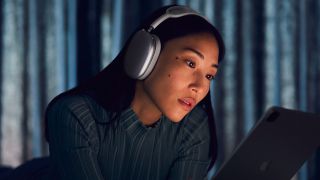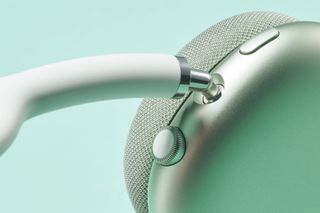Here's what AirPods Max 2 should steal from AirPods Pro 2 – and what it shouldn't
The next AirPods Max would benefit from most of AirPods Pro 2's changes, but not all…

Now that Apple has unveiled AirPods Pro 2 to the world, the next item in the AirPods line-up that needs an upgrade is AirPods Max, Apple's high-end over-ear headphones.
A new AirPods Max 2 model doesn't look likely to arrive any time soon – we'd guess that the end of the 2023 is the most likely time we'll see it, because Apple loves to release AirPods models just before Christmas. It did this with the original AirPods Max, AirPods 3rd Gen, AirPods Pro 2 and original AirPods Pro (2019).
There haven't been many leaks about AirPods Max 2, which is one reason why we're not expecting them appear soon, but it's likely that they'll share a bunch of features with AirPods Pro 2, just as the originals did with the first AirPods Pro.
So here's what we'd like to see Apple transplant from its elite noise-cancelling earbuds into its over-ear headphones – but also two elements we hope it leaves in the Pros.
1. Do update Adaptive Transparency and active noise cancellation
Well, this is a gimme, right? The AirPods Max are actually already among the best noise-cancelling headphones, even a couple of years after their launch – their noise-blocking power is impressive even when compared to the likes of the newer and almighty Sony WH-1000XM5.
And their Transparency mode was already better than the original AirPods Pro, doing a much better job of mixing outside sounds with the music. So there's less worth to be done here overall.
But that just means the bar could be raised even higher with the next model, doesn't it? Especially when you factor in the H2 chip that's crucial to the mind-blowing noise cancellation in the AirPods Pro 2 – we could get all the benefits of the Adaptive Transparency mode (such as clamping down on loud exterior noises while still letting in most sound), but with even bigger and better speakers powering it.
Get daily insight, inspiration and deals in your inbox
Get the hottest deals available in your inbox plus news, reviews, opinion, analysis and more from the TechRadar team.
2. Do offer a more flexible fit for different heads
Apple didn't change the exterior design of the AirPods Pro 2, but its inclusion of an extra-small in-ear tip for the first time was an acknowledgment that three sizes didn't fit all in the earlier version, and that more options were needed for everyone to get a great fit from it.
I hope a second version of the AirPods Max bring the same kind of thinking, albeit in maybe a slightly different manner. The original AirPods Max have a tight and secure clamping feel to their design, which is designed to help distribute their weight (they're a lot heavier than the likes of the Bose QC45) as well as ensuring a good seal to passively block noise.
The problem is that fit tends to be really love-it-or-hate-it. I've given the AirPods Max to people who find them super-comfortable for long periods, but also to people who couldn't stand them immediately. And I had an interesting journey myself – with one pair of my glasses, I can wear them all day; with a different pair, I start to feel the pressure after a couple of hours.
I've never seen such a different opinion of fit in a pair of headphones before, and never experience such a big change depending on my glasses myself, so I'm hoping that a second version might follow the AirPods Pro 2's lead and work on being more comfortable for all.

3. Do improve battery life
This is another slam dunk, you have to assume. The 20-hour battery life on the AirPods Max is fine, but it's far behind the 30 hours you get from the similarly high-end Bowers & Wilkins PX8… and way, way behind the 60 hours you get from the Sennheiser Momentum 4 Wireless.
The AirPods Pro 2 added about 50% more battery life to the buds compared to the predecessor, largely thanks to the more efficient H2 chip powering them. You'd hope that we'll see the same kind of improvement from AirPods Max 2, bringing them to 30 hours to keep up with the likes of the B&W and Sony… though I don't expect them to match the Sennheisers.
4. Do add UWB location finding
AirPods Pro 2 added an ultra-wideband (UWB) chip to their repertoire this year, which means that if they're lost, you can literally use your iPhone to point you towards them, because this wireless tech can tell you direction and range to an object (within a certain distance).
This is much more important in the tiny AirPods Pro case than in the much-chunkier AirPods Max, but it'd still be a great update to have available in there, in case you left them in a bag or threw them in a drawer and just aren't sure where to start looking. You'd be able to fire up the Find My app straight away and save a bunch of time.

5. Don't add touch controls
Okay, we're onto the things we don't want AirPods Max to borrow from AirPods Pro 2 now. The AirPods Pro 2 expanded their on-bud control by adding touch-based volume controls – you swipe up or down to change this. This works… fine. It's not very natural, and it's a little too easy to do accidentally in my opinion, but I've still found myself using it, so fair enough.
There have been suggestions (based on an Apple patent) that AirPods Max 2 will use touch controls instead of the current Digital Crown volume and play/pause control (basically a, ahem, dialled up version of what you find on the Apple Watch), and I really hope that the next AirPods Max won't follow the Pro 2's lead by having touch-based volume controls.
I love the Digital Crown on the AirPods Max. It, and the physical button for noise cancellation next to it, are my favorite control system for over-ear headphones. It's so reliable – I can just reach up and it's right under my finger where I expect it to be, and then you just turn a little for fine volume control.
On something like the Sony WH-1000XM4 where you have a big touch pad that does everything, you have to reach up, guess if your finger is in the right spot, then swipe in a direction you think is up to do volume. There's too much guesstimation in it – with AirPods Max's physical controls, I never get it wrong.
6. Don't change to a punchier sound
AirPods Pro 2 sound great – they're a big step up over the original for the complete soundstage, and there's notably more detail and dynamism to them. But I find them a little on the aggressive side – they're quite forward and in-your-face compared to the originals… and compared to the AirPods Max.
The AirPods Max manage to offer deep and rich bass, delicate and clear treble, and clear and focused mid-range, all while being fairly natural and laid back about it. Sound doesn't feel like it's being pumped right in your ears by powerful speakers – they're a remarkably easy and unfatiguing listen over long periods (assuming the fit is good for you over that time).
I hope they next version will keep closer to that sound profile – while I'm using and enjoying the AirPods Pro 2 every day happily, I do think they could stand to chill out by 10% or so.
Don't forget to keep you eye on our guides to the best AirPods Black Friday deals over the next few months, if you're thinking of buying any of the current models!

Matt is TechRadar's Managing Editor for Entertainment, meaning he's in charge of persuading our team of writers and reviewers to watch the latest TV shows and movies on gorgeous TVs and listen to fantastic speakers and headphones. It's a tough task, as you can imagine. Matt has over a decade of experience in tech publishing, and previously ran the TV & audio coverage for our colleagues at T3.com, and before that he edited T3 magazine. During his career, he's also contributed to places as varied as Creative Bloq, PC Gamer, PetsRadar, MacLife, and Edge. TV and movie nerdism is his speciality, and he goes to the cinema three times a week. He's always happy to explain the virtues of Dolby Vision over a drink, but he might need to use props, like he's explaining the offside rule.
Most Popular

